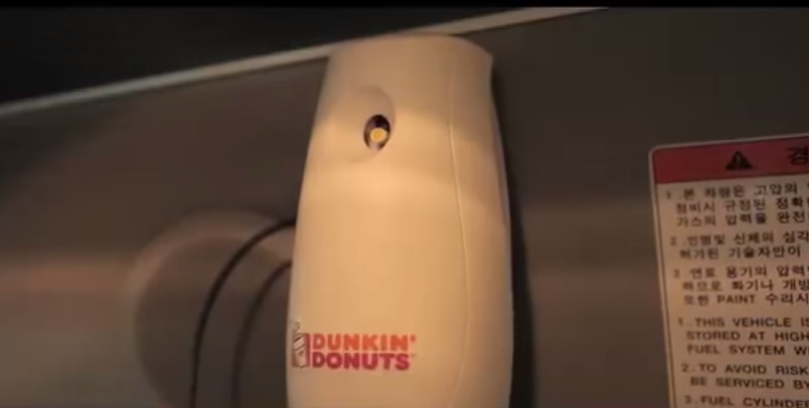Aromattic
Coffee has a pretty distinctive aroma — for many people, the smell alone can help them wake up, although it likely leads to a craving for a cup. If you’re Starbucks, Tim Horton’s, or Coffee Bean and Tea Leaf, that aroma can be a pretty powerful tool for that very reason. Of course, it’s a hard thing to use to your advantage, at least from a marketing standpoint. It’s not very often that you, the coffee shop, can make the smell of a freshly-brewing pot simply appear in front of the nose of would-be customers.
But in late 2011 or early 2012, a marketing agency working came up with a way to not only get that smell in front of the weary, but also to do so in a way which would associate the smell with their client, Dunkin Donuts. The idea was called “Flavor Radio” and, if you were on a bus in Seoul, South Korea during the months-long experiment, there’s a good chance you were blasted with coffee odors during your morning commute.
Bus advertising is nothing new — in many cities, you’ll see ads on both the outside and inside of the city buses. The inside ads are particularly interesting because you have a captive audience — you aren’t reaching that many people (it’s limited to those who actually get on the bus), but for those whom you do reach, you have the time to get a good amount of information to them. Buses in Seoul take this opportunity to the next level, allowing for audio. The buses play jingles and other ads during the trip.
Many commuters were already in the habit of buying their morning coffee when they got off the bus — that’s unsurprising — but Dunkin Donuts wasn’t seeing a lot of those commuters entering their stores. Dunkin was associated with the junk food pastries, not hot liquid caffeine (at least in South Korea). The company wanted to change that and their creative agency, Cheil Worldwide, had an idea. Cheil rigged machines — something akin to air fresheners, as the Atlantic notes — which listened for the Dunkin Donuts jingle and spritzed out some coffee smells in response. The machines, an example of which can be seen below, were then installed in the buses.

The agency then redid the on-bus audio advertisements to take advantage of this new technology. The new Dunkin ads led with the jingle, making sure that the aroma flew out at the start of the pitch. Most of the ad afterward centered on a discussion between man and a woman who noticed the smell, wondering if they had just walked into a Dunkin Donuts franchise; riders, therefore, were clued in that the coffee smell they had just taken in was no coincidence. Then, at the end, another voice noted that no, there’s no coffee on the bus, but there’s a Dunkin Donuts right near the riders’ bus stops. To reinforce the message, many bus shelters were outfitted with Dunkin Donuts ads — no smells this time, though — directing riders to nearby Dunkin Donuts locations.
The agency estimated that 350,000 bus riders were exposed to the “Flavor Radio” campaign, and during the campaign, Dunkin Donut chains near these bus stops saw a 16% increase in visitors. More importantly, coffee sales during that period went up 29%, according to the agency (per this video they made). So there’s good reason to believe the campaign worked. It also won a prestigious award for “best use of ambient media.”
But don’t expect it to expand, at least not any time soon. There are few public transit systems which play radio-style ads to begin with, and few are going to add smells to the offering.
 Bonus Fact: In Spain, you’ll not find any “Dunkin Donuts.” That’s because it’s “Dunkin Coffee” there. This isn’t a marketing ploy, hoping to get you to start your day there, though; it’s an intellectual property work-around. When the donut/coffee chain opened in Spain, the term “Donut” was trademarked there by another bakery chain. Dunkin and that bakery opened a series of “Dunkin Donuts” stores throughout the nation, but in 2007, Dunkin bought out the partner’s interest. In doing so, they lost the right to use the “Donuts” name in their title, and switched to “Dunkin Coffee.” (Could be worse.)
Bonus Fact: In Spain, you’ll not find any “Dunkin Donuts.” That’s because it’s “Dunkin Coffee” there. This isn’t a marketing ploy, hoping to get you to start your day there, though; it’s an intellectual property work-around. When the donut/coffee chain opened in Spain, the term “Donut” was trademarked there by another bakery chain. Dunkin and that bakery opened a series of “Dunkin Donuts” stores throughout the nation, but in 2007, Dunkin bought out the partner’s interest. In doing so, they lost the right to use the “Donuts” name in their title, and switched to “Dunkin Coffee.” (Could be worse.)
Double bonus!: As seen in this photo gallery, Dunkin Donuts isn’t the only coffee that uses artificial smells to its advantage — Starbucks has been at it, too.
From the Archives: The Nose Knows: Disney’s similar attempts at letting your nose be your guide. (To cookies, in one case.)
Related: Dunkin coffee.
